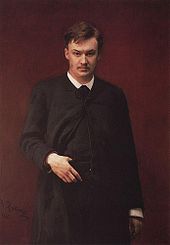2nd Symphony (Glasunow)

The 2nd Symphony in F sharp minor op. 16 by the Russian composer Alexander Glasunow (1865–1936) was premiered in 1886 and is dedicated to the memory of Franz Liszt .
Emergence
As early as 1883, one year after the successful premiere of his symphonic debut , Glasunow began collecting material for his 2nd and 3rd symphonies. The instrumentation of the 2nd symphony took place largely in the summer of 1886 in Helsinki , where Glasunow spent vacation days with his brothers and their teacher BI Sokolow. In the summer of 1886, Glasunov also received news of Franz Liszt's death, which prompted him to dedicate the symphony to his memory. Liszt had initiated a performance of Glasunov's 1st Symphony in Weimar in 1884 and received the young composer there very warmly.
World premiere and reception
In the autumn of 1886 Georg Dütsch conducted the world premiere of Glasunov's 2nd Symphony in F sharp minor. For the Paris World's Fair in 1889 , the publisher and patron Glasunov, Mitrofan Beljajew , had scheduled two concerts of Russian music; at the second on June 23, Glasunow himself successfully conducted a. a. his 2nd symphony. In the same year the work was first printed as Opus 16 by the music publisher MP Belaieff (Leipzig).
Cast and characterization
Instrumentation: 3 flutes (1st / 2nd flute also piccolo ), 2 oboes , 2 clarinets , 2 bassoons , 4 horns , 2 trumpets , 2 trombones , tuba , timpani , percussion and strings.
Sentence sequence:
- I. Andante maestoso. Allegro
- II. Andante
- III. Allegro vivace
- IV. Intrada: Andantino sostenuto - Finale: Allegro
The playing time is about 45 minutes.
Glazunov's 2nd Symphony is stylistically influenced on the one hand by Alexander Borodin , on the other hand it shows a turn to Liszt's monothematic compositional principles: a theme that sounds at the beginning of the first movement in unison with the brass shapes the whole symphony motto-like and returns in various transformations in the following movements again, so in the middle part of the slow movement and rhythmically modified in the trio of the third movement. It is also taken up again in the final.
Individual evidence
literature
- Detlef Gojowy : Alexander Glasunow . List Verlag, Munich 1986, ISBN 3-471-77644-3 , pp. 31, 69, 71-72.
- CD supplement Orfeo C 148 101 A: Glasunow: 2nd symphony a. a., Bamberg Symphony, conducted by Neeme Järvi. Text: Reinhard Schulz
- CD supplement BIS CD-1308: Glasunow: 2nd Symphony a. a., BBC Nat. Orch. Of Wales, Ltg Tadaaki Otaka. Text: Marina Lobanova
Web links
- 2nd Symphony (Glasunow) : Sheet music and audio files in the International Music Score Library Project